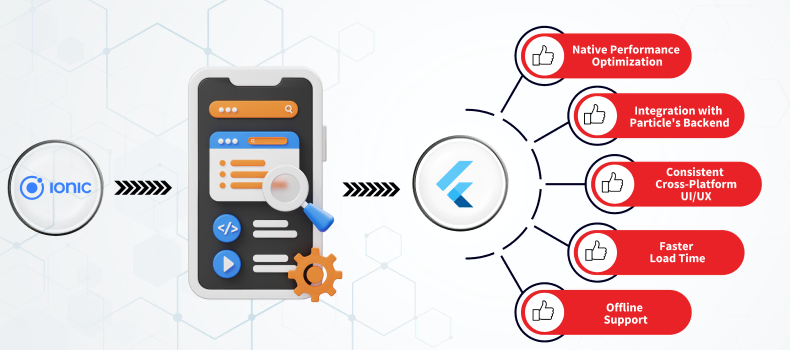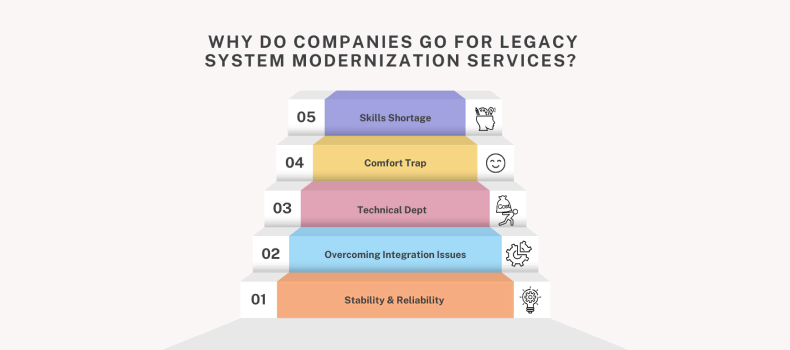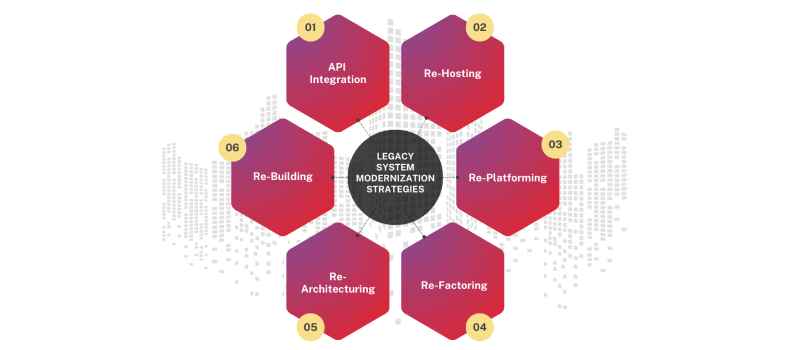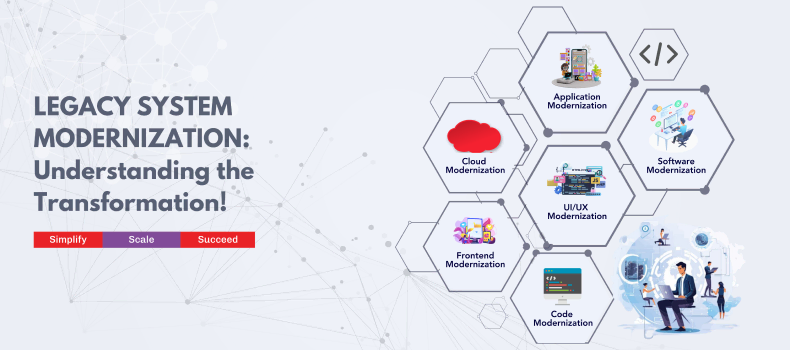What is legacy System Modernization
What is Legacy System Modernization?
IT Legacy System Modernization is an open-ended path leading to digital transformation. It is a continuous process of transforming your old legacy applications & software for better performance & reduce IT environment complexity and costs. It uses technology to migrate the legacy code to the modern platforms allowing organization to increase data security, platform integration & flexibility.
We notice companies work with their ongoing systems for years on years cutting them off with the new technologies, latest upgradations, integrations etc. In the current business era, change is constant, quickly adapting to the customers demands to create new products is crucial. Legacy System Modernization not only unlock company’s legacy systems potential but also modernize to better respond to the emerging technologies.
While approaching Legacy System Modernization developing a solid Modernization strategy is the primary focus.
iProgrammer rebuilt a sales and leads tracking mobile app in flutter replacing the previous Ionic framework (frontend). It offers more real-time updates, smart notifications, lead scoring, and seamless CRM integration, boosting productivity and sales outcomes. The transition from Ionic to Flutter addressed key pain points such as lagging performance, inconsistent UI/UX across platforms, andlimited access to native features. Debugging was complex and time-consuming, while customization and fragmentation issues affected overall app performance. Compatibility problems with outdated Cordova plugins further contributed to user frustration and hindered effective lead management, making the upgrade to Flutter essential.

– Improved app responsiveness and smooth user interactions across both Android and iOS platforms.
– Full access to native device functionalities (e.g., camera, push notifications) for a more efficient and feature-rich experience.
– Smoother app maintenance.
– More user retention and engagement because of reduction in apps initial load time.
– Scalable frontend that supports future growth and additional feature requirements without performance degradation.
Benefits of Legacy System Modernization
Cost Advantage – You can re-write your code with modern languages which helps you to reduce the cost of hiring developers to maintain code that only few can work with. As we speak with our clients, Legacy System Modernization reduces the IT Budget by 50% which is incurred from growing support tickets and managing old code.
Productivity – The basic idea of the iProgrammer is to shift your developers to the cloud and make them more productive in day to day activities. For e.g., rewriting your code for the cloud cleans up various technical limitations of your earlier code, hence your development team is more familiar with the latest trends and technologies to address the issue or add new features.
Data Consistency and Security – Modernizing ensures your data is readily available for flow by integrating it to various platforms & improving Data Management practices. You also get regular security updates to prevent advanced cyber threats, old systems are generally targeted by hackers as they get access without much resistance.
User Experience – Legacy System Modernization gives your customers best possible user experience by altering web and mobile applications to make the end users journey more smooth. System Modernization integrates your existing systems with latest technologies such as artificial intelligence, big data, blockchain and machine learning to personalize client queries.
Regulatory Compliance – Data privacy and security regulations continuously evolve and Legacy Systems may not keep up with these regulations. Not updating the older systems may lead to serious compliance issues and legal challenges especially in the finance and healthcare sector. For e.g. If in a banking industry you handle customer’s sensitive data and use Legacy Systems you may unknowingly or unknowingly violate one or more regulations, potentially subjecting your company to substantial fines and reputation damage.
Flexibility and Mobility – Many legacy programs are device-specific, making it difficult for users to access and interact with the system using current devices such as smartphones. For e.g if your Software Development team uses outdated device-centric software, it will be difficult for them to complete the task in the remote working phase or if there is some problem with the device the work may stop. Modernizing Legacy systems can help you to make your code device compatible so that there is no halt in task completion.
Competitive Advantage – Imagine being in a banking industry where other banks deploy modern generative AI, digital banking experience to customers, cloud computing technologies, ticketing systems, automation in risk management etc. If you are using the same outdated systems you risk losing customers to your most immediate competitors.
Why do companies go for Legacy System Modernization Services

Stability & Reliability – Legacy systems are vulnerable to crashes and failures as a result of poorly maintained software, sporadic maintenance, and complex or outmoded architectures that are difficult to manage and diagnose. As a result, firms are vulnerable to operational disruptions and security breaches. They are also built on old wireframes and architecture which does not cater to scalability requirements which can result to downtimes and low response times. This becomes a problem when systems are not able to handle big data, customer requirements, data integrity and compliance. When the cloud comes in the picture with modernization it allows scalability and improved system performance which can handle big data without manual intervention without any risk of security.
Integration Issues – Companies that use Legacy Systems often face compatibility issues with new platform integration. Consequently, substantial time and financial resources go towards maintaining the legacy system. Legacy System Modernization Services keep your system up to date for integration introducing next-gen technologies that can boost functionality and ease the software’s user-friendliness and compatibility.
Technical Dept – Technical dept occurs when the project owner chooses a quick solution to a problem instead of going with a comprehensive and responsible approach. Technical dept often occurs because it can be time-consuming to effectively update system quality. These shortcuts can result in poor code quality or fixes that do not always address the underlying cause of the problem. Hence Legacy system modernization comes into the picture when reducing technical dept by reconstructing and refactoring the code.
Comfort Trap – Over a period of time we found out that the legacy systems are continuously running without major failures. This fear of disruption makes businesses cautious of implementing changes. Thus to upgrade the employee’s Legacy System Modernization is necessary as even the employees working on a particular system may resist switching to newer technologies even when its more flexible and stable.
Skills Shortage – When more advanced systems are used the demand for the skillsets for new systems becomes higher while the requirements for the legacy systems skillsets diminish. Companies working on Legacy Systems might face the issues of skill shortages & may be difficult to find people to maintain, secure and update their system capabilities. Modernizing legacy systems not only ensures that organizations have enough resources to maintain their systems, but it also ensures that businesses can remain competitive, meeting high client demands and remaining ahead of the curve in a fast-paced sector.
To know more read our blog on 7 Signs to Choose Legacy System Modernization
How to modernize legacy systems without disruption?
Technological Analysis – Examine programming languages, codes, database that may pose risk or limitations in the implementation process. Based on evaluation identify if your tech stack can handle the upcoming challenges. In the technical analysis also go for Code Review and UI/ UX Review – Identify bugs and areas where code can be improved but evaluate how easily the code can be understood, modified, and extended. Outdated UI UX design makes the system difficult to use, especially when new features are added. That’s why the UI UX design needs to be evaluated to ensure the software is user-friendly and accessible to everyone.
Modularity – Design the system into smaller, unconstrained each responsible for their own functionality. This strategy is critical for ensuring the system’s agility, whether you choose a microservices or monolithic architecture. Begin the transfer with smaller, simpler, and more isolated services, such as email, authentication, and document management. Successfully moving these components boosts confidence and gives a clear roadmap for dealing with larger, more linked domains.
Leveraging API – Our experience suggests achieving a smooth transition is through the adoption of APIs and microservices architecture. Both these technologies play a crucial role in ensuring that legacy systems can integrate with modern solutions without requiring a complete overhaul of the system. API allows the older systems to integrate with the newer ones minimizing the risk of significant downtime and disruptions to ongoing processes.
Stakeholders Training – Stakeholders, including managers, customers, and higher management must be engaged throughout the modernization journey to reduce resistance, and facilitate smooth transitions. In the entire process of modernization ensure that the it teams have regular access to feedback and encourage open dialogue communication regarding the issues.
Using Agile and DevOps Methodology – Key benefits of Agile in Modernization is it converts the modernizing into smaller parts rather than full scale overhaul. Each path can focus on specific modernization tasks, such as upgrading a particular module, refactoring code, or improving system performance, ensuring that progress is measurable and consistent. DevOps fosters a culture of collaboration between these traditionally separate teams, leading to more streamlined workflows, automation, and continuous delivery.
Challanges and considerations in legacy system modernization Services

Acceptance – It is difficult for employees to accept and work with the new systems in their everyday routines. Hence whenever there is legacy system modernization, the same efforts should be taken to get the acceptance from the employees. Adequate training and communication must be done to adapt to the new systems so that there is no productivity and frustration issues.
Integration – The organizations should be ready with a plan of what applications or systems will be used with the newer systems. They need to check the newer applications are compatible to be used with the legacy systems as they contain large amounts of data on the schema or data formats. So integrating the older systems with modern systems such as cloud, microservices or API can lead to data loss and can put data integrity at risk.
Cost – Replacing the entire Legacy System is a huge financial burden on an organization. Various challenges arise when the migration is in progress such as scope issues, security issues and data incompatibility – All these costs associated with the modernization effort need to be carefully considered before any decisions are taken. There are also some hidden costs such as training costs, new infrastructure costs and consultancy costs which also should be taken into consideration.
Documentation – If there is no proper documentation, reverse engineering will be required to understand how the legacy system worked. Many legacy systems lack up-to-date documentation, making it difficult to understand their architecture, functionality, and dependencies.
Time Pressure – Legacy System Modernization can be a challenging task when there are strict deadlines for delivering new features or updates. Adopting an agile approach opens path for incremental development and delivers updates in smaller parts thus making it easily scalable to complete on time.
Legacy System Modernization Strategies

API Integration – It involves covering the system’s core functionality & exposing it through API or service layers. It is used when old systems need to interact with newer systems without changing the system’s codebase thus extending the lifecycle of the legacy systems. This strategy is mostly used in the Banking industry where a bank uses APIs to integrate with modern banking servers while providing modern digital services to its customers.
Re-hosting – It refers to transferring an entire legacy system from one infrastructure to another (in most of the cases – Cloud) without updating any code. Rehosting is one of the most efficient and cost-effective solutions to upgrade outdated systems since it enables enterprises to employ cloud infrastructure without having to rewrite or rework the application. Rehosting also leverages the organizations to scale the systems based on demand and transferring the system to the cloud helps in disaster recovery and security.
Re-platforming – It is a bridge between Rehosting and Refactoring which allows legacy systems to move to a new platform but with minimal changes. Small changes are made to make the system feasible for better integration with modern systems. If the organization wants to improve performance without complete migration, Re-platforming is the best option. Mostly used by e-Commerce platforms to leverage features like auto-scaling, load balancing, and database optimization without needing to rewrite the entire application.
Re-factoring – This strategy involves cleaning up the entire code of the existing system making it more usable for optimized performance. Refactoring is operated in a microenvironment where each module or each code is focused to improve its readability, performance, and scalability. Mostly used by the Logistics Industry, this strategy is the best to reduce technical debt, reducing the risk of major disruptions.
Re-architecting – This strategy involves redesigning the application’s architecture to meet modern standards. Rearchitecting is more encroaching than rehosting or re-platforming, as it requires significant changes to how the system is designed and developed. This strategy makes the systems more scalable and flexible.
Rebuilding – This strategy is used when the legacy systems are completely outdated, and a full revamp is necessary. While this strategy provides completely redeveloping the legacy system from scratch, it comes with the challenge of potential disruptions during the transition. This approach allows organizations to redesign the system based on current business needs, eliminate technical debt, and take full advantage of modern computing technologies, such as AI, cloud computing, or blockchain.
iProgrammer & Legacy System Modernization Services

We, at iProgrammer Solutions Pvt Ltd, focus upon legacy system transformation toward agile, high-performance digital solutions that today’s changing market dynamics demand.
Our legacy system modernization approach is all-inclusive: starting from a detailed assessment of your existing infrastructure. We are collaborative with you, exploring what your business processes look like and what you want to achieve and pain points within the process. This helps us create bespoke modernization plans for specific rehosting, refactoring, or complete re-architecture. iProgrammer has successfully performed numerous modernization projects for clients from various sectors, including banking and healthcare, which means no system is too complex for us to handle. We ensure business continuity with a 99% uptime guarantee. This transition will be smooth, efficient, and cost-effective.
We modernize your systems but support and maintain them over time for your systems to remain optimized and adaptable to the future business needs. It is a choice for innovation, reliability, and expertise that will enable your business to thrive in the digital age by choosing iProgrammer as your legacy system modernization partner.









